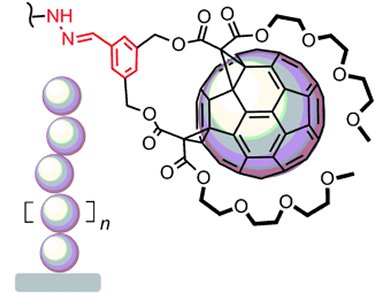The alignment of fullerenes along oligothiophene stacks (see picture) has received much attention due to its importance for organic solar cells. The directional assembly of 1D fullerene channels is difficult, however, very important for directional electron transfer along redox gradients, similar to those found in biological photosystems.
Stefan Matile and co-workers, University of Geneva, Austria, introduced self-organizing surface initiated polymerization (SOSIP) as a method to grow functional multicomponent architectures directly on solid substrates. Therein, surface-initiated ring-opening disulfide-exchange polymerization is combined with molecular recognition to grow charge-transporting π stacks on indium tin oxide surfaces with molecular-level precision.
The team combines this method with templated stack exchange (TSE). SOSIP architectures are grown in the presence of templates on the surface and templates along the stack. The benzaldehyde templates are then removed with hydroxylamine, and the large holes are filled by hydrazone formation with formyl-fullerene.
This method gives facile access to double-channel photosystems with oriented strings of fullerenes along oriented stacks of oligothiophenes.
 Self-Organizing Surface-Initiated Polymerization of Multicomponent Photosystems: Stack Exchange with Fullerenes,
Self-Organizing Surface-Initiated Polymerization of Multicomponent Photosystems: Stack Exchange with Fullerenes,
Altan Bolag, Hironobu Hayashi, Pierre Charbonnaz, Naomi Sakai, Stefan Matile,
ChemistryOpen 2013.
DOI: 10.1002/open.201300004




